

3110 Marentette Avenue, Windsor, Ontario, N8X 4G2
Tel: 519.966.9733 - Fax: 519.966.6301
| Home | History | All About Coffee |
Location/ Contact Us |
Roaster's Tips & Recipes |
Gifts of Good Taste |
Office Coffee Service |
Our Store |
Virtual Tour |
Links |
Restaurant Blends
Specialty Blends
Teas
Chai
Hot Chocolate
Sesame Bread
Sticks
Breading &
Batter
Fresh Salads
Soup Salad
& Seasonings
Syrups
Brewing
Equipment & Accessories
All Products
in one page
2oo5 Gift Basket Pricing Guide
(PDF)
(Excel)
| 10 Steps to Coffee | What Is Coffee |
| Coffee From Around The World | |
| How to Brew Coffee | The Value of Coffee |

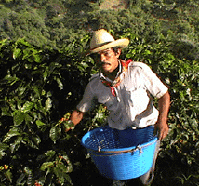
Coffee Picker in Costa Rica
High on a lush, steep hillside covered with coffee trees, a picker carries a heavy bag filled with a long day's work. The bag contains ripe, red coffee cherries. Months from now, the beans from that day's harvest might be the very ones you purchase at your favorite store. Between the time that he picked them and you purchase them, the beans went through a series of steps very much like this. ~

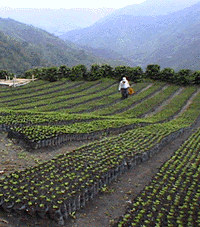
A coffee bean is actually a seed. When dried, roasted and ground, it is used to brew coffee. But if the seed is not processed, it can be planted and will grow into a coffee tree.
Coffee seeds are generally planted in large beds in shaded nurseries. After sprouting, the seedlings are removed from the seed bed to be planted in individual pots in carefully formulated soils. They will be watered frequently and shaded from bright sunlight until they are hearty enough to be permanently planted.
Planting often takes place during the wet season, so that the soil around the young trees remains moist while the roots become firmly established.

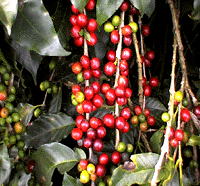
Coffee Cherries
Depending on the variety, it will take approximately 3 or 4 years for the newly planted coffee trees to begin to bear fruit. The fruit, called the coffee cherry, turns a bright, deep red when it is ripe and ready to be harvested. In most countries, the coffee crop is picked by hand, a labor-intensive and difficult process, though in places like Brazil, where the landscape is relatively flat and the coffee fields immense, the process has been mechanized. Whether picked by hand or by machine, all coffee is harvested in one of two ways:
Strip Picked - the entire crop is harvested at one time. This can either be done by machine or by hand. In either case, all of the cherries are stripped off of the branch at one time.
Selectively Picked - only the ripe cherries are harvested and they are picked individually by hand. Pickers rotate among the trees every 8 - 10 days, choosing only the cherries which are at the peak of ripeness. Because this kind of harvest is labor intensive, and thus more costly, it is used primarily to harvest the finer arabica beans.
In most coffee-growing countries, there is one major harvest a year; though in countries like Colombia, where there are two flowerings a year, there is a main and secondary crop.
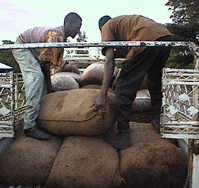
Coffee transported in bags in Ethiopia
A good picker averages approximately 100 to 200 pounds of coffee cherry a day, which will produce 20 to 40 pounds of coffee beans. At the end of a day of picking, each worker's harvest is carefully weighed and each picker is paid on the merit of his or her work. The day's harvest is then combined and transported to the processing plant.

Once the coffee has been picked, processing must begin as quickly as possible to prevent spoilage. Depending on location and local resources, coffee is processed in one of two ways.
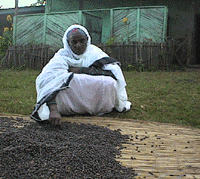
Coffee drying on a mat

This is the age-old method of processing coffee and is still used in many countries where water resources are limited. The freshly picked cherries are simply spread out on huge surfaces to dry in the sun. In order to prevent the cherries from spoiling, they are raked and turned throughout the day, then covered at night, or if it rains, to prevent them from getting wet. Depending on the weather, this process might continue for several weeks for each batch of coffee. When the moisture content of the cherries drops to 11 percent, the dried cherries are moved to warehouses where they are stored.

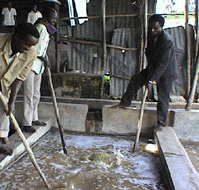
Wet method processing
In wet method processing, the pulp is removed from the coffee cherry after harvesting and the bean is dried with only the parchment skin left on. There are several actual steps involved. First, the freshly harvested cherries are passed through a pulping machine where the skin and pulp is separated from the bean. The pulp is washed away with water, usually to be dried and used as mulch. The beans are separated by weight as they are conveyed through water channels, the lighter beans floating to the top, while the heavier, ripe beans sink to the bottom.
Next they are passed through a series of rotating drums which separate them by size.
After separation, the beans are transported to large, water-filled fermentation tanks. Depending on a combination of factors -- such as the condition of the beans, the climate and the altitude -- they will remain in these tanks for anywhere from 12 to 48 hours. The purpose of this process is to remove the slick layer of mucilage (called the parenchyma) that is still attached to the parchment; while resting in the tanks, naturally occurring enzymes will cause this layer to dissolve. When fermentation is complete the beans will feel rough, rather than slick, to the touch. At that precise moment, the beans are rinsed by being sent through additional water channels. They are then ready for drying.

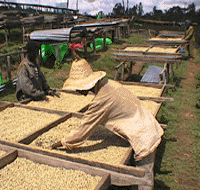
Drying beans in the sun
If the beans have been processed by the wet method, the pulped and fermented beans must now be dried to approximately 11 percent moisture to properly prepare them for storage. These beans, still encased inside the parchment envelope (the endocarp), can be sun dried by spreading them on drying tables or floors, where they are turned regularly, or they can be machine dried in large tumblers. Once dried, these beans, referred to as 'parchment coffee,' are warehoused in sisal or jute bags until they are readied for export.~

Before it is exported, parchment coffee is processed in the following manner:
Hulling - Machines are used to remove the parchment layer (endocarp) from wet processed coffee. Hulling dry processed coffee refers to removing the entire dried husk -- the exocarp, mesocarp & endocarp -- of the dried cherries.
Polishing - This is an optional process in which any silver skin that remains on the beans after hulling is removed in a polishing machine. While polished beans are considered superior to unpolished ones, in reality there is little difference between the two.
Grading & Sorting - Before being exported, the coffee beans will be even more precisely sorted by size and weight. They will also be closely evaluated for color flaws or other imperfections.
Typically, the bean size is represented on a scale of 10 to 20. The number represents the size of a round hole's diameter in terms of 1/64's of an inch. A number 10 bean would be the approximate size of a hole in a diameter of 10/64 of an inch and a number 15 bean, 15/64 of an inch. Beans are sized by being passed through a series of different sized screens. They are also sorted pneumatically by using an air jet to separate heavy from light beans.
Next defective beans are removed. Though this process can be accomplished by sophisticated machines, in many countries, it is done by hand while the beans move along an electronic conveyor belt. Beans of unsatisfactory size, color, or that are otherwise unacceptable, are removed. This might include over-fermented beans, those with insect damage or that are unhulled. In many countries, this process is done both by machine and hand, insuring that only the finest quality coffee beans are exported.

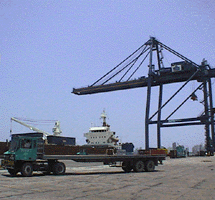
A coffee port - Cartegena, Colombia
The milled beans, now referred to as 'green coffee,' are ready to be loaded onto ships for transport to the importing country. Green coffee is shipped in either jute or sisal bags which are loaded into shipping containers, or it is bulk shipped inside plastic-lined containers. Approximately seven million tons of green coffee is produced worldwide each year.

At every stage of its production, coffee is repeatedly tested for quality and taste. This process is referred to as 'cupping' and usually takes place in a room specifically designed to facilitate the process. First, the taster -- usually called the cupper -- carefully evaluates the beans for their overall visual quality. The beans are then roasted in a small laboratory roaster, immediately ground and infused in boiling water, the temperature of which is carefully controlled. The cupper "noses" the brew to experience its aroma, an integral step in the evaluation of the coffee's quality. After letting the coffee rest for several minutes, the cupper "breaks the crust" by pushing aside the grounds at the top of the cup. Again the coffee is nosed before the tasting begins.
To taste the coffee, the cupper "slurps" a spoonful with a quick inhalation. The objective is to spray the coffee evenly over the cupper's taste buds, and then "weigh" it before spitting it out. Samples from a variety of batches and different beans are tasted daily. Coffees are not only analyzed this way for their inherent characteristics and flaws, but also for the purpose of blending different beans or determining the proper roast. An expert cupper can taste hundreds of samples of coffee a day and still taste the subtle differences between them.

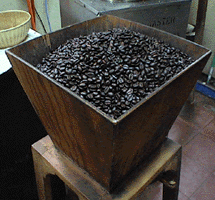
Roasted beans in Costa Rica
Roasting transforms green coffee into the aromatic brown beans that we purchase, either whole or already ground, in our favorite stores. Most roasting machines maintain a temperature of about 550 degrees Fahrenheit. The beans are kept moving throughout the entire process to keep them from burning and when they reach an internal temperature of about 400 degrees, they begin to turn brown and the caffeol, or oil, locked inside the beans begins to emerge.
This process, called pyrolysis is at the heart of roasting. It is what produces the flavor and aroma of the coffee we drink. When the beans are removed from the roaster, they are immediately cooled either by air or water. Roasting is generally performed in the importing countries because freshly roasted beans must reach the consumer as quickly as possible.

The objective of a proper grind is to get the most flavor in a cup of coffee. How coarse or fine the coffee is ground depends on the method by which the coffee is to be brewed. Generally, the finer the grind the more quickly the coffee should be prepared. That is why coffee ground for use in an espresso machine is much finer than coffee which will be brewed in a drip system.

Before you brew your coffee, take a moment to look carefully at the beans. Smell their aroma. Think of the many processes that these beans have gone through since the day they were hand-picked and sorted in their origin country. Consider the long way they have traveled to your kitchen. Prepare your coffee thoughtfully and enjoy it with pleasure. Many people have been instrumental in bringing it to your cup!

Everyone recognizes a roasted coffee bean but unless you have lived or traveled in a coffee growing country, you might not recognize an actual coffee tree. Pruned short in cultivation, but capable of growing more than 30 feet high, a coffee tree is covered with dark-green, waxy leaves growing opposite each other in pairs. Coffee cherries grow along the tree's branches. It takes nearly a year for a cherry to mature after the flowering of the fragrant, white blossoms. Because it grows in a continuous cycle, it is not unusual to see flowers, green fruit and ripe fruit simultaneously on a single tree. The trees can live as long as 20 - 30 years and are capable of growing in a wide range of climates, as long as there is no harsh fluctuation in temperature. Optimally, they prefer a rich soil and mild temperatures, with frequent rain and shaded sun.
Botanical Classification
Coffee traces its biological heritage to a genus of plants known as Coffea. Within the genus there are over 500 genera and 6,000 species of tropical trees and shrubs. The genus was first described in the 18th century by the Swedish botanist, Carolus Linneaus, who also described Coffea arabica in his Species Plantarum in 1753. Botanists have disagreed ever since on the exact classification. This is understandable considering that coffee plants can range from small shrubs to tall trees, with leaves from 1 to 40 centimeters in size, and from purple or yellow, to the predominant dark green, in color. It has been estimated that there are anywhere from 25 to 100 species of coffee plants.
A complete classification of coffee:
| Kingdom | Vegetable |
| Sub-Kingdom | Angiospermae |
| Class | Dicotyledoneae |
| Sub-Class | Sympetalae |
| Order | Rubiales |
| Family | Rubiaceae |
| Genus | Coffea |
| Sub-Genus | Eucoffea |
| Species | C. arabica |
| C. canephora |
In the commercial coffee industry, there are two important coffee species -- arabica and canephora, more commonly called robusta.

Coffea arabica -- C. arabica
Varieties: Bourbon, Typica, Caturra, Mundo Novo, Tico, San Ramon, Jamaican Blue Mountain
Coffea arabica is descended from the original coffee trees discovered in Ethiopia. These trees produce a fine, mild, aromatic coffee and represent approximately 70 percent of the world's coffee production. On the world market, arabica coffees bring the highest prices. The better arabicas are high grown coffees -- generally grown between 2,000 to 6,000 feet above sea level -- though optimal altitude varies with proximity to the equator. The important factor is that temperatures must remain mild, neither too hot nor too cold, ideally between 59 - 75 degrees, with about 60 inches of rainfall a year. The trees are hearty but a heavy frost will kill them. Arabica trees are costly to cultivate because the terrain tends to be steep and access difficult. Also, because the trees are more disease prone than robusta, they require additional care and attention. Arabica trees are self pollinating. The beans are flatter and more elongated than robusta and lower in caffeine.

Coffea canephora -- C. canephora var. robusta
Variety: Robusta
Most of the world's robusta is grown in Central and Western Africa, parts of Southeast Asia, including Indonesia and Vietnam, and in Brazil. Production of robusta is increasing, though it accounts for only about 30 percent of the world market. Genetically, robusta carries fewer chromosomes than arabica and the bean itself tends to be slightly rounder and smaller than an arabica bean. The robusta tree is heartier, more disease and parasite resistant, which makes it easier and cheaper to cultivate. It also has the advantage of being able to withstand warmer climates, preferring constant temperatures between 75 and 85 degrees, which enables it to grow at far lower altitudes than arabica. It requires about 60 inches of rainfall a year and cannot withstand a frost. Compared with arabica, robusta beans produce a coffee which has a distinctive taste and about 50-60% more caffeine. Robusta is primarily used in blends and for instant coffees.
The Anatomy of a Coffee Cherry
The coffee cherry's outer skin is called the exocarp. Beneath it is the mesocarp, a thin layer of pulp, followed by a slimy layer called the parenchyma. The beans themselves are covered in a parchment-like envelope named the endocarp, more commonly referred to as 'the parchment.' Inside the parchment, side-by-side lie two beans, each covered separately by yet another layer of thin membrane. The biological name for this membrane or seed skin is the spermoderm, but it is generally referred to in the coffee trade as the 'silver skin.'


Coffee trees produce their best beans when grown at high altitudes in a tropical climate where there is rich soil. Such conditions are found around the world in locations along the Equatorial zone, between latitudes 25 degrees North and 30 degrees South.
Besides location, other factors affect the quality and flavor of coffee. These include the variety of the plant, the chemistry of the soil in which it is grown, the weather, particularly the amount of rainfall and sunshine, and the precise altitude at which the coffee grows. Such variables -- combined with the way the cherries are processed after being picked -- contribute to the distinctions between coffees from countries, growing regions and plantations worldwide. The combination of factors is so complex, that even from a single plantation one finds variation in quality and taste.
Coffee is grown in more than 50 countries around the world. Here are just a few.
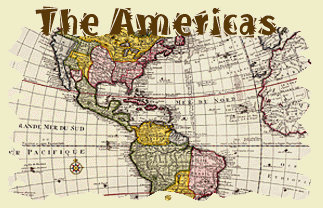

Though coffee farms are found throughout the Hawaiian islands, it is Kona coffee, from the large island of Hawaii, that is best known and always in high demand. Nature provides just the right environment for the coffee trees growing on the slopes of the active Mauna Loa volcano. Young trees are planted in black, volcanic soil so new that it often seems the farmers are planting their seedlings in rock instead of soil. Afternoon shade from tropical clouds forms a natural canopy over the trees to protect them from intense sun. Frequent island showers keep the plants nourished with just the right amount of rain. Kona coffee is carefully processed and produces a deliciously rich, aromatic cup of medium body.
Though coffee in Mexico primarily comes from small coffee farms rather than large plantations, coffee farmers number over 100,000 and Mexico ranks as one of the largest coffee producing countries in the world. Most of the farms are located in the south of the country, primarily in the states of Veracruz, Oaxaca and Chiapas. A cup of Mexican coffee can offer a wonderful aroma and a depth of flavor, often with a pronounced sharpness. It is an excellent bean for dark roasts and is often used in blends. A Mexican coffee designated Altura means that it was high grown.
Coffee was brought to Puerto Rico from Martinique in 1736 and by the late 19th century Puerto Rico was the 6th leading exporter of coffee in the world. But the coffee industry in Puerto Rico did not maintain its world standing. Major hurricanes and competition from other coffee producing countries forced the island to seek other means for economic survival. Today, however, the coffee industry is being revived and Puerto Rico is again producing fine coffees. Coffees grown there are carefully cultivated from quality arabica varieties and produced to the highest standards. There are two major growing regions on the Caribbean island: Grand Lares in the south central and Yauco Selecto in the southwest. Excellent coffees come from both regions, noted for their balanced body and acidity and fruity aroma.

Guatemala is a country working hard to bring higher visibility and uniform quality to a well-established coffee industry. Not always as well-known as some of its Central and South American neighbors, Guatemala's coffees have a distinctive taste quality favored by many for its rich flavor. There are three main growing regions -- Antigua, Coban and Heuhuetanango -- and in each, one finds a breath-takingly rugged landscape and rich volcanic soil. Microclimates strongly influence the quality and flavor of the Strictly Hard Beans grown at altitudes 4500' or higher. In the cup, a Guatemalan is a medium-to-full bodied coffee, often with a depth and complexity of taste that is almost spicy or chocolatey to the tongue.
A Central American coffee-growing country with a reputation for fine coffee, Costa Rica produces only wet processed arabicas. With its medium body and sharp acidity, cuppers often describe a Costa Rican coffee as having 'perfect balance.' Coffee is grown on predominantly small farms, or fincas. After being harvested, the cherries are immediately taken to state-of-the-art processing facilities, known as beneficios, where wet method processing begins. In Costa Rica, careful attention to quality processing and conscientious growing methods are consistent with a fine quality coffee.

Colombia, the world's best-known producer of coffee, ranks second worldwide in yearly production. Colombia takes this position seriously and works very hard to maintain a high standard of excellence. The result is consistently good coffee grown carefully and with great pride on thousands of small family coffee farms across the country. An extremely rugged landscape provides the perfect natural environment for the growth of the coffee. But a terrain so rugged has also made it historically difficult to transport the harvested coffee beans to production and shipment centers. Even today, this is often done by mule or Jeep. Such care and attention results in consistently good, mild coffees, with a well-balanced acidity. Colombian Supremo, the highest grade, has a delicate, aromatic sweetness while Excelso Grade might be softer and slightly more acidic.
Brazil is unquestionably the biggest coffee producing country in the world. With a seemingly endless expanses available for its production, coffee plantations in Brazil often cover immense areas of land, need hundreds of people to manage and operate them, and produce huge quantities of coffee. A 'Brazilian' coffee is a 'mild' and the two terms are often used interchangeably. Both arabica and robusta are grown, though in different coffee growing regions. The ambient climate, soil quality and altitude largely determine which variety will grow best in which region. A fine cup of Brazilian is a clear, sweet, medium-bodied, low-acid coffee.
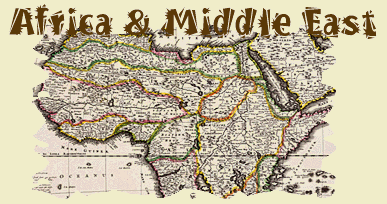

Coffee legend tells of the discovery of the first coffee trees in Ethiopia. Indeed, it is not hard to believe that coffee originated in a land where wild coffee tree forests are still the primary source of harvested coffee. Generally wet processed, coffee from Ethiopia comes from one of three main growing regions -- Sidamo, Harer or Kaffa -- and often bears one of those names. In the cup, an Ethiopian coffee tends to offer a remarkable and bold statement. It is full flavored, a bit down-to-earth and full bodied.
Kenyan coffee is well-known and well-liked, both in both the United States and Europe. Kenyan beans produce a singular cup with a sharp, fruity acidity, combined with full body and rich fragrance. Coffee is grown on the foothills of Mount Kenya, often by small farmers. Kenyan producers place an emphasis on quality and as a result, processing and drying procedures are carefully controlled and monitored. Kenya has its own unique grading system. Kenyan AA is the largest bean in a 10-size grading system and AA+ means that it was estate grown.

On the west coast of Africa, the Ivory Coast is one of the world's largest producers of robusta coffee. Coffees from the Ivory Coast are strongly aromatic with a light body and acidity. They are ideally suited for a darker roast and are therefore, often used in espresso blends.

In the country where coffee was first commercially cultivated, one still finds coffee growing in the age-old, century-proven manner. Within the small, terraced gardens of family farms, one can almost always find a few coffee trees. Water is scarce in this arid land and coffee beans grown here tend to be smaller, and more irregular in size and shape. Lack of water also means that the coffee cherries will be dry processed after harvest. The result is that one finds in Yemeni coffee a distinctive taste that is deep, rich and like no other.
In ancient times, when coffee was shipped from the famous Yemeni port of Mocha to destinations all over the world, the word 'Mocha' became synonymous with Arabian coffee. The Dutch combined Arabian coffee with coffee grown on the island of Java, thus making popular the first coffee blend -- one that is still well-known today -- Mocha Java.

Indonesia, one of the world's largest countries, is composed of thousands of islands. Several of the larger islands -- Sumatra, Java and Sulawesi (or Celebes as it was called) -- are known throughout the world for the fine, quality coffees which grow there. The coffee plant was introduced to Indonesia by Dutch colonists in the 17th century and soon led the world's production. Today, small coffee farms of 1-2 acres predominate and most of it is dry processed. Indonesian coffees are noted for a pronounced rich, full body and mild acidity.
Indonesia is also known for its fine aged coffees. Traditionally, these were coffees held over a period of time by farmers who wanted to sell them at higher prices. Warehousing, it was found, gently aged the coffee in Indonesia's warm, damp climate and resulted in an coffee prized for even deeper body and less acidity. It is a process which cannot been matched by technology.
Another Asian country with a large coffee production is Vietnam. Coffee originally came to this country in the mid-nineteenth century when French missionaries brought arabica trees from the island of Bourbon and planted them around Tonkin. They flourished. More recently, coffee has been re-introduced and the coffee industry is growing so rapidly that Vietnam is rapidly becoming one of the world's largest producers. Today, small plantations, located in the southern half of the country, produce mostly robusta coffee. In the cup, Vietnamese coffee has a light acidity and mild body with a good balance. It is frequently used for blending.

There are many methods for brewing a fine cup of coffee -- no single technique is right for everyone. The method you choose for brewing your coffee should be based on your needs and your unique coffee preferences. Do you want a hearty mug of coffee for breakfast? An afternoon cappucino? Or a dessert espresso? Do you prefer a milder coffee or a more robust coffee flavor?
The quality and flavor of your coffee is not only determined by the brewing process you prefer but also by the type of coffee you select. For example, what country is the coffee from, what region and what variety of coffee tree? Or is it a blend from several countries, regions or varieties? Do you favor a dark roast coffee, a light blend or something in between? What kind of grind have you selected? Remember to be creative -- you can choose a dark espresso roast coffee and still have it ground to be brewed in a drip system.
But no matter how you choose to brew your coffee, there are guidelines to follow which will give you the best cup of coffee possible. To optimize the quality of every cup of coffee you prepare, fine-tune your brewing routine by incorporating these suggestions.


Make sure that your equipment is thoroughly cleaned after each use by rinsing it with clear, hot water and drying it with an absorbant towel. Check that no grounds have been left to collect on any part of the equipment and that there is no build-up of coffee oil. Such residue can impart a bitter, rancid flavor to future cups of coffee.

Purchase coffee as soon after it has been roasted as possible. Fresh roasted coffee is essential to a superb cup of coffee. And purchase your coffee in small amounts -- only as much as you can use in a given period of time. Ideally you should purchase your coffee fresh every 1-2 weeks.


If you purchase whole bean coffee, always grind your beans as close to the brew time as possible. A burr or mill grinder is preferable because all of the coffee is ground to a consistent size. A blade grinder is less preferable because some coffee will be ground more finely than the rest. If you normally grind your coffee at home with a blade grinder, try having it ground at the store with a burr grinder. You may be surprised at the difference!
Do not underestimate the importance of the size of the grind to the taste of your coffee. If your coffee tastes bitter, it may be overextracted, or ground too fine. On the other hand, if your coffee tastes flat, it may be underextracted, meaning that your grind is too coarse. Tell the professionals where you purchase your coffee exactly how you will be brewing it. For example, will you be using a plunger pot? A flat drip filter? A cone drip filter? A gold mesh filter? They will grind it specifically for the preparation method you have chosen and the equipment you use.
Before using the coffee, try rubbing some of the grounds between your fingers so that you can 'feel' the grind and become acquainted with the differences in size.

Never reuse your coffee grounds. Once brewed, the desirable coffee flavors have been extracted and only the bitter undesirable ones are left.

The water you use is VERY important to the quality of your coffee. Use filtered or bottled water if your tap water is not good or imparts a strong odor or taste, such as chlorine. If you are using tap water let it run a few seconds before filling your coffee pot. Be sure to use cold water. Do not use distilled or softened water.

Use the proper amount of coffee for every six ounces of water that is actually brewed, remembering that some water is lost to evaporation in certain brewing methods. A general guideline is 1 to 2 tablespoons of ground coffee for every six ounces of water. This can be adjusted to suit individual taste preferences. Be sure to check the 'cup' lines on your brewer to see how they actually measure.

Your brewer should maintain a water temperature between 195 - 205 degrees Fahrenheit for optimal extraction. Colder water will result in flat, underextracted coffee while water that is too hot will also cause a loss of quality in the taste of the coffee. If you are brewing the coffee manually, let the water come to a full boil, but do not overboil. Turn off the heat source and allow the water to rest a minute before pouring it over the grounds.

The amount of time that the water is in contact with the coffee grounds is another important factor affecting the taste of your coffee. In a drip system, the contact time should be approximately 5 minutes. If you are making your coffee using a plunger pot, the contact time should be 2-4 minutes. Espresso, as the name implies, means that the brew time is short -- the coffee is in contact with the water for only 20-30 seconds. If the taste of your coffee is not optimal, it is possible that you are either overextracting (the brew time is too long) or underextracting (the brew time is too short) your coffee. Experiment with the contact time until you can make a cup of coffee that suits your tastes perfectly.

Brewed coffee should be enjoyed immediately!
Pour it into a warmed mug or coffee cup so that it will maintain its temperature as long as possible. Brewed coffee begins to lose its optimal taste moments after brewing so only brew as much coffee as will be consumed immediately. If it will be a few minutes before it will be served, the temperature should be maintained at 180 - 185 degrees Fahrenheit. It should never be left on an electric burner for longer than 15 minutes because it will begin to develop a burned taste. If the coffee is not to be served immediately after brewing, it should be poured into a warmed, insulated thermos and used within the next 45 minutes.
Never reheat your coffee.

A finely prepared cup of coffee should be enjoyed as thoughtfully as it was brewed. Take a moment to smell the aroma. Take a sip and notice your coffee's flavor. How does it compare to other coffees with regard to body, acidity and balance? If it is a coffee that is new to you, notice how it is different. If it is what you normally drink, note its degree of freshness or how simple changes in preparation affect the cup's flavor.
A steeping cup of coffee will not last long, but every sip is meant to be savored and enjoyed!



By any name, in any language, or at any time of day, coffee is a popular beverage. Aside from its great taste and the endless ways one can enjoy a cup of coffee, coffee is also a great value. Did you know that, on average, you pay less than a dime for each cup of coffee you prepare at home?
Here is something else you may not know about coffee - before being roasted, coffee beans are green. Unroasted coffee -- known in the industry as green coffee -- is sold as a commodity on the world market. The cost of coffee is, therefore, affected by anything that alters the worldwide supply, such as drastic weather conditions like freezing temperatures or drought. But even with occasional price increases, coffee is still inexpensive, especially compared to the cost of other beverages.

Coffee is available in a wide variety of beverages and flavors to satisfy even the most discriminating tastes. In fact, a recent U.S. survey revealed that 69 percent of American coffee drinkers consider coffee to be an "affordable luxury." And, when you stop to consider the social aspect of one of America's most popular beverages - friends and family conversing other over mugs of delicious, fresh-brewed coffee - the value of coffee takes on an even greater meaning.


Coffee travels a long way before reaching your coffee mug.
Here are some interesting coffee facts:
It takes three-to-four years for a coffee seed to grow into a tree that produces coffee beans.
Seeds are first planted in nurseries. Six months to one-year later, seedlings are transplanted to open fields. Workers must prepare the planting ground for the small seedlings by loosening and grading the soil.
Approximately two-and-a-half years after transplantation, the trees begin to flower and the flowers produce a small fruit known as a coffee cherry. In the center of each cherry are two green coffee beans.
Coffee plants grow best where there is plenty of rainfall at certain times of the year and thrive in a well-drained, rich, volcanic soil. The plant does not like sudden changes in temperature, and frost can severely damage or kill it.
During harvest, coffee cherries are hand picked. It takes approximately 2,000 cherries -- 4,000 beans -- to produce one pound of roasted coffee.
After being husked, sorted and bagged, the green coffee beans are shipped from the countries where they were grown to the countries where they will be manufactured and consumed.
Manufacturing involves the roasting and grinding of the coffee beans, or the production of instant coffee. Once manufacturing and packaging are completed, the coffee is ready for the consumer.
The leading coffee producing countries of the world are Brazil and Colombia. The United States imports and consumes more coffee than any other country.



Coffee manufacturers have worked to improve both the quality and variety of coffee in recent years, and coffee drinkers have noticed the difference. A recent U.S. survey showed that almost 70 percent of American coffee drinkers believe that the quality of coffee they consume both at home and away is better than it used to be.
Now more than ever, coffee drinkers can enjoy a variety of coffee beverages -- from a simple espresso and espresso-based drinks such as cappuccino, latte or moccaccino -- to iced and cold-drink coffee beverages -- to flavored coffees and special blends. Coffee can also be enhanced with an assortment of syrups, flavorings, and toppings -- from whipped cream and cocoa powder to cinnamon sticks and sweeteners.
Enjoy coffee with friends and family. Many people drink coffee regularly and will not be able to resist an invitation for a coffee break. For less than the price of other beverages, you can prepare a coffee drink to suit anyone's taste.






